The comforting sound of a chickadee’s familiar “chicka-dee” call is often heard on cold winter mornings, perhaps as you step outside to feel the chill in the air with your favorite steaming beverage in hand. This year-round resident bird will likely find you relatively harmless, and will continue with its two-“dee” version of the call. If there are more “dees”
— count next time you hear them — it may have mistaken you for a predator and sounded its alarm call.
More Backyard Birds: Warblers | American Goldfinches | Hummingbirds | American Kestrels | Northern Flickers | Owls | Woodpeckers | Jays
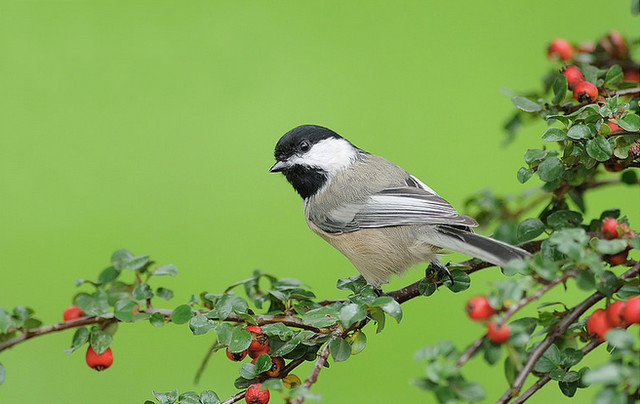
Lindapp57
Chickadees rank as one of the cutest and most well-loved songbirds. Rightly so. Anyone who spends time observing them notices their curious, brave and social nature. With the quick tilts of their heads as they study you, it is as though you could narrate their every move. Read on to learn more about these tiny, tenacious songbirds. But be warned, you may fall in love with these chickadee, dee, dee, dees.
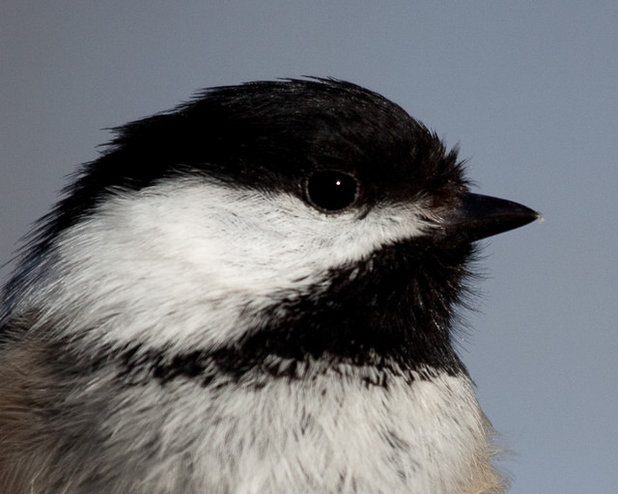 Photo by David A Mitchell
Photo by David A Mitchell
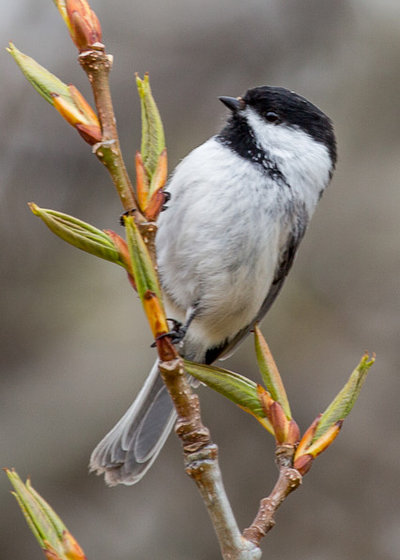 Common names and scientific names:
Common names and scientific names: Black-capped chickadee (
Poecile atricapillus),
Carolina chickadee (
P. carolinensis),
mountain chickadee (
P. gambeli), boreal chickadee (
P. hudsonicus)
and
chestnut-backed chickadee (
P. rufescens)
Distribution: Black-capped chickadees have the most extensive range for North American chickadees. They can be found as far north as Alaska, across the northern U.S. and many parts of Canada, and as far south, at higher elevations, as Tennessee in the east and New Mexico in the west.
The Carolina chickadee resides in the Carolinas, as its name implies, as well as west to Texas, from northern Florida to Ohio.
You can find the mountain chickadee in the dry evergreen forests of the mountainous west, from the Mexican border to the southern Yukon.
North of that is boreal chickadee territory, as its name is derived.
The chestnut-backed chickadee maintains a smaller range along the coast of the Pacific Northwest. These ranges can slightly overlap, and it is possible to see two species of chickadees where their habitats intersect.
Photo by David A Mitchell
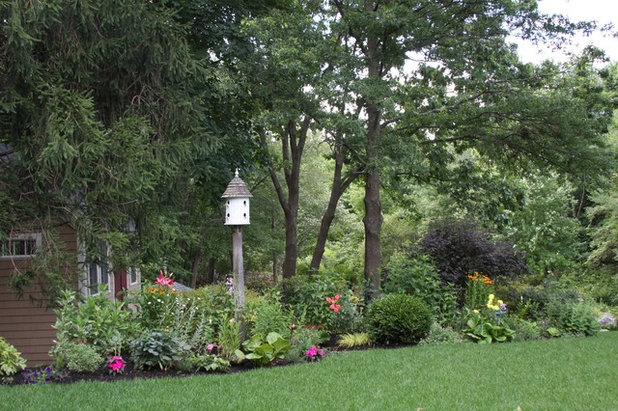
Amy Martin Landscape Design
Habitat: Chickadees are found in a variety of habitats; their main criteria is the presence of trees or woody shrubs. This flexibility is one of the reasons chickadees are present in wilderness, rural, suburban and urban areas.
Some species require more specific habitats, like the mountain chickadee, which prefers evergreen trees and higher elevations. The boreal chickadee lives only in the boreal forests of Canada. But in general, chickadees will make a home just about anywhere they can forage, visit bird feeders and nest.
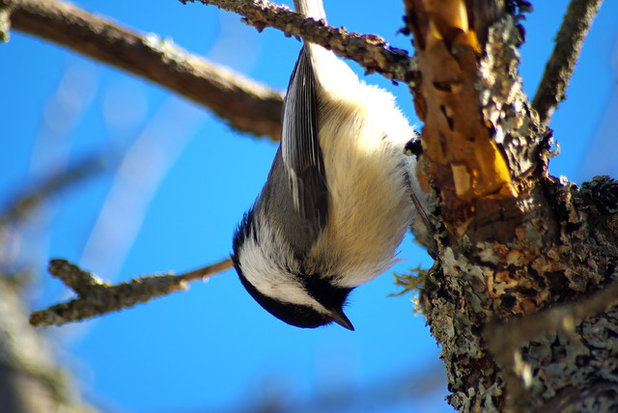 How to Identify ThemBlack-capped chickadees
How to Identify ThemBlack-capped chickadees have a well-deserved name, with their spherical black head and beard, or bib, that runs from their beak down their short neck. Thick white patches split these dashing black features and run from their bill to the back of their head or neck. Their chests and stomach are a creamy white with gray wings edged in white highlights.
Their beaks are short and thicker than a warbler’s but thinner than a finch’s, making them excellent seed eaters. Their stout bodies, large heads and curious charm make them a joy to observe.
Photo by Andrew Feicht
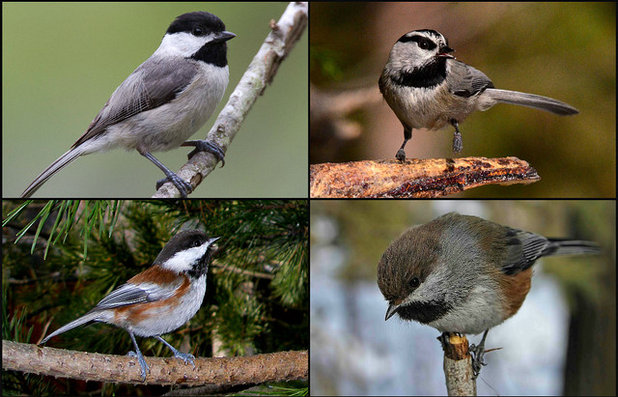 Carolina chickadees
Carolina chickadees (upper left) are almost identical to black-capped chickadees; their range is the most accurate way to differentiate them.
The
mountain chickadee (upper right) has a white stripe above the eye, setting it apart from the black-capped and Carolina chickadees.
The
boreal chickadee (lower right) has a brownish cap with rufous flanks, instead of the black head of the others species of chickadees.
The
chestnut-backed chickadee (lower left), named appropriately for its chestnut back and shoulders, is a darker slate gray than the lighter gray found on other chickadees.
Photos by, clockwise from top left, Dan Pancamo,
Eugene Beckes,
John Plzniur,
Thomas Quine
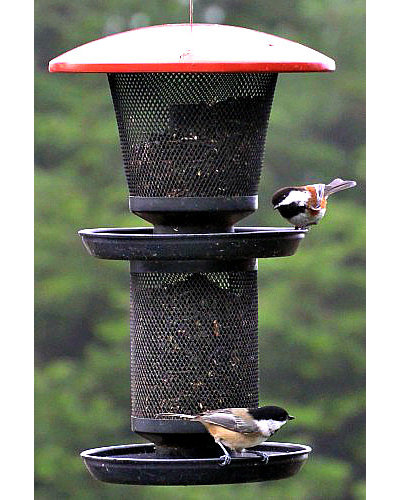
Eric Gardner
Here we see a black-capped and chestnut-backed chickadee. This photo was likely taken in the Northwest, where chestnut-backed and black-capped ranges overlap.
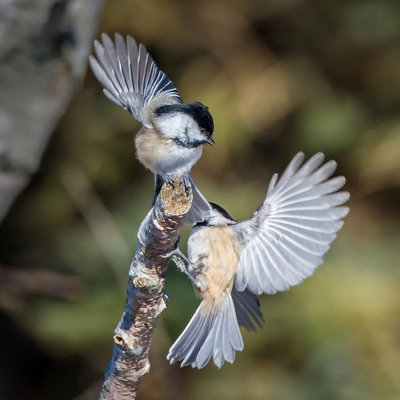
Helena Chu
Differences between females and males. Chickadee males and females have a single plumage pattern — meaning the males and females look identical. Identifying males and females requires watching their behavior or having a keen ear to differentiate male from female song. Researchers are just beginning to document and understand their songs.
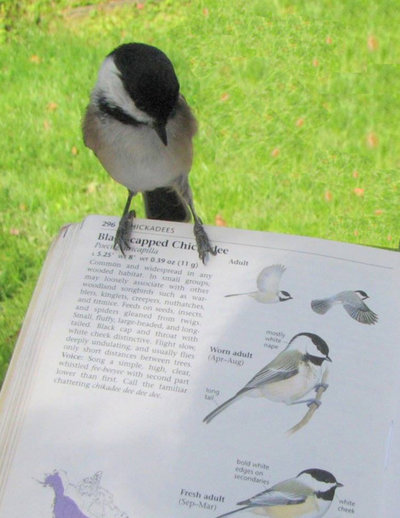
Mary Batcheller
How to Attract ChickadeesHang bird feeders. For those who love to feed birds, chickadees are your feeder champions. Researchers found that chickadees can visit one feeder more than 200 times a day. If you have feeders in regions where chickadees live, you are bound to see these feathery friends over and over again. In fact, in New York state during the 2014 to 2015 Project FeederWatch season, chickadees were the No. 1 bird, documented at 97 percent of participant feeders.
If you set up feeders, consider providing their favorite snacks, like sunflower seeds, peanuts, suet, peanut butter and mealworms. If you love watching chickadees at your feeders, consider becoming a participant of Project FeederWatch; your observations will be entered as data for scientists to analyze when studying the health, distribution and population changes of birds.
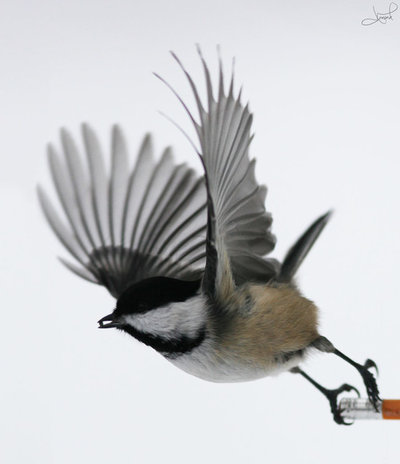
Chickadees will stash seeds, commonly known as caching, in thousands of different locations in their territories and return to them when in need of a high-calorie meal. This is especially necessary on cold winter days, when they are busy maintaining their body temperature or roosting alone on a below-freezing night.
Every fall they start regenerating neurons at a faster rate than at other times of the year, probably so their brains can keep up with all the new seed caches they have to remember. Their brains have the capacity to remember thousands of cache locations, which is a necessary survival strategy.
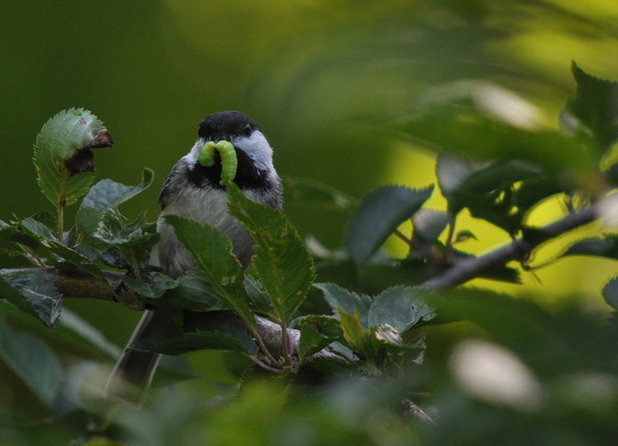
Deborah Bifulco
Plant native trees, shrubs and flowers. In the spring and early summer, however, their diet consists almost completely of insects and spiders. These high-protein diets are needed for chickadees to feed themselves and their growing offspring during breeding season. To provide sufficient food for them during the mating season, have a diversity of native trees, shrubs and flowers to attract the creepy-crawly meals they require.
Browse plants native to your region of the U.S.
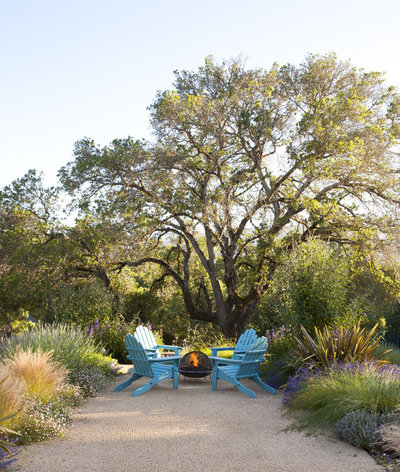
Arterra Landscape Architects
Doug Tallamy, professor at the University of Delaware, studies the relationship between chickadees and native plants, and has found that native trees host the greatest diversity of the preferred chickadee food, caterpillars; oak trees (
Quercus spp.) and coast live oak (
Quercus agrifolia,
USDA zones 9 to 11; find your zone) shown here, top the list. These native trees are important because, as he also reports, a typical pair of nesting chickadees will bring in about 8,000 individual caterpillars to feed one clutch of eggs.
Feeders are a great way to support chickadees in the winter, but for them to thrive and reproduce successfully, we must consistently create and maintain native landscapes that attract native insects.
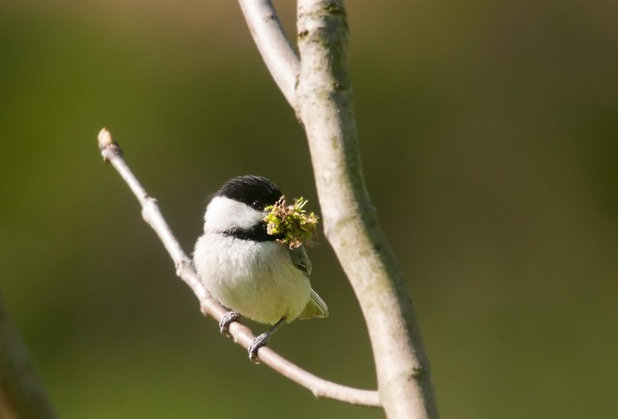 Nesting
NestingMale and female chickadees often work together to excavate a hole for nesting after the female has found an appropriate location. Often they will seek out alder (
Alnus spp.) or birch (
Betula spp.) trees if they are available, but will settle for most snags or rotten branches. The soft decomposing wood allows the birds’ smaller beaks to successfully shape a hole that is about 8 inches (21 centimeters) deep to contain a cup-shaped nest composed of wood chips, lichen and animal fur. Chickadees will build nests at ground level up to 66 feet (20 meters) off the ground, but they will generally nest between 4.9 feet (1.5 meters) and 23 feet (7 meters) off the ground.
Photo by Kelly Colgan Azar
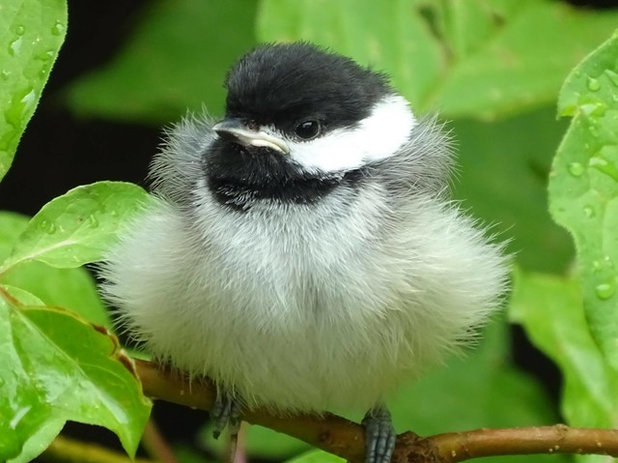
Peter Pereira
They generally lay one clutch, which can range from one to 13 eggs. The male and female will work together, using their acrobatic talents to catch insects, to feed their developing offspring. If you notice fewer chickadees at bird feeders during breeding season, generally April to June, it is because they are very busy catching insects to feed their offspring, which cannot thrive on seeds, since these birds are insectivores, not granivores.
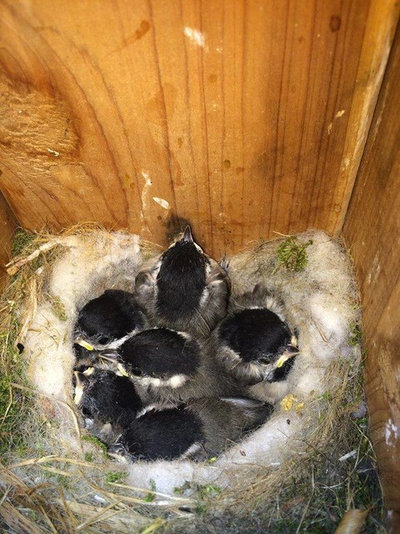
Lisa Caddell
Interested in building a nest box for chickadees? Use the birdhouse plans from NestWatch to ensure a safe and usable nest box for your resident chickadees. This project is a moderately easy one and makes a lovely gift for just about anyone in North America.
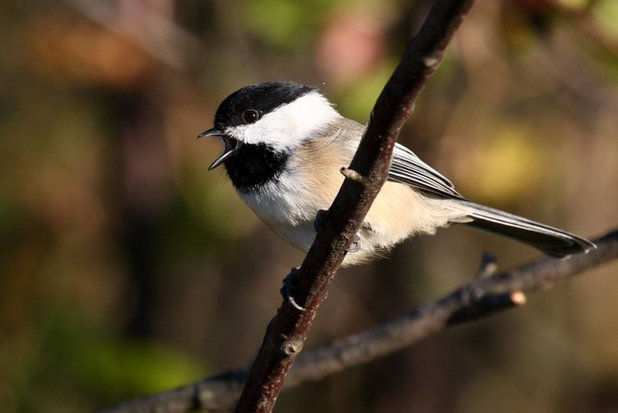 Chickadee: The Vocalizer
Chickadee: The VocalizerChickadees are complex communicators. Their alarm call is used and relied upon across species of birds that associate with chickadees, such as nuthatches, woodpeckers and other songbirds. Their calls can communicate the identity of other birds, location of a new food source and threat levels of a predator.
Exciting new findings reveal that males and females have acoustically unique songs, and chickadees can tell the difference between male and female chickadee vocalizations.
Photo by Tim Lenz
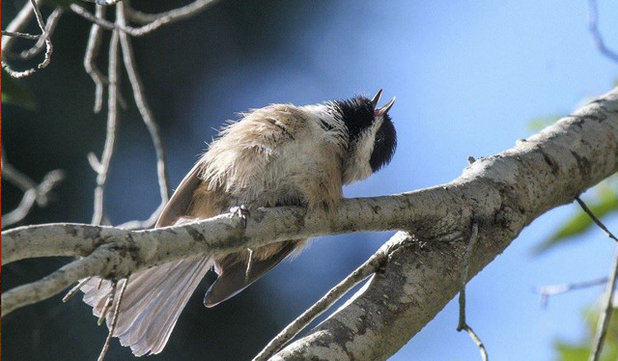
Judy Fairchild
Communicative, clever chickadees are a treat for the novice birder and the bird enthusiast alike. Their chatter, stealthy harvest of seeds and genuine curiosity make observing them an adventure. This winter, consider pulling up a chair to listen to and watch these birds in your yard or at a feeder. See if you can keep up with their complex communications as they engage socially, forage, stash seeds and give alarm calls. They may be little, but they are mighty survivors.
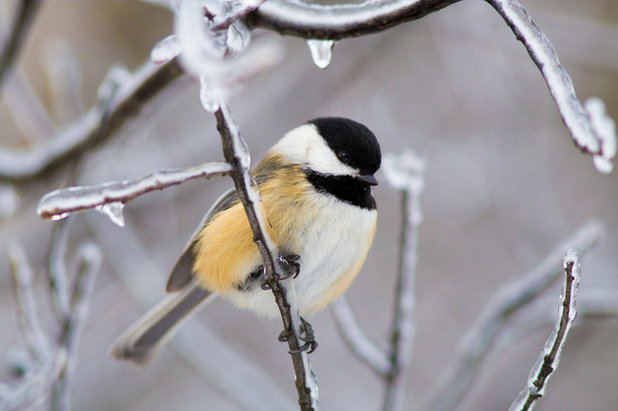 Learn more about different chickadee species:
Learn more about different chickadee species: Mountain Chickadee | Carolina Chickadee | Boreal Chickadee | Chestnut-Backed Chickadee
YardMap is a citizen science project developed by the Cornell Lab of Ornithology, designed to cultivate a richer understanding of bird habitat, for both professional scientists and people concerned with their local environment. Thousands of people are documenting their conservation efforts at home to support birds and other wildlife in their yards.Photo by davejdoeSee more ways to welcome birds to your garden





